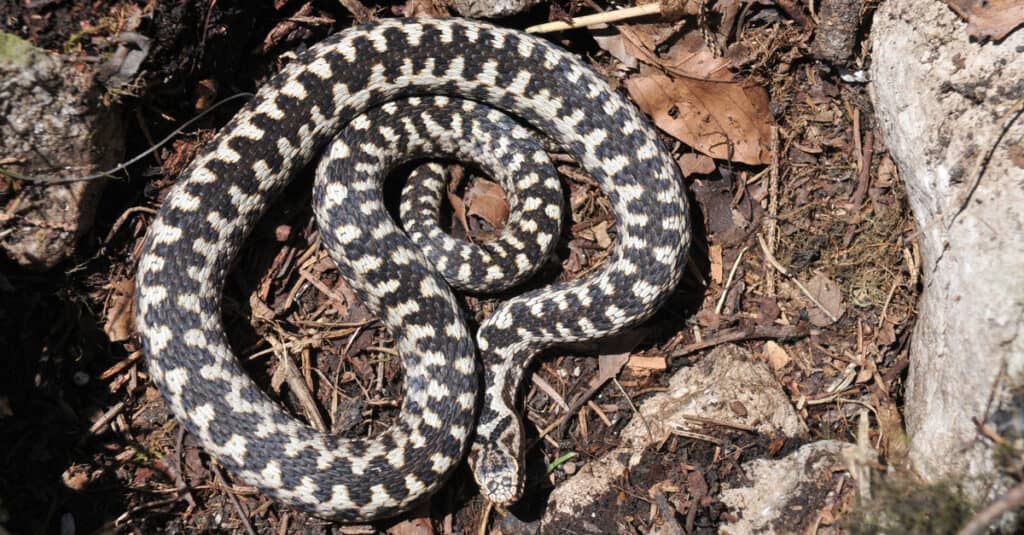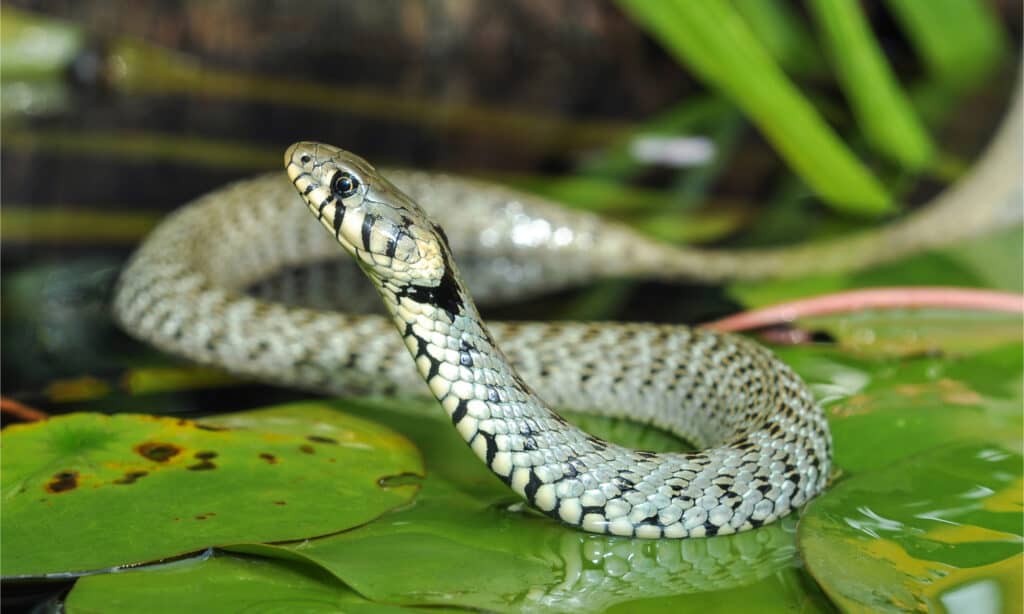When you think of the United Kingdom, you’re probably more likely to think of Queen Elizabeth II, Stonehenge, and the Loch Ness monster than snakes. This may come as a surprise to you — many people are shocked to find that England is home to snakes at all. But, the British Isles are in fact home to three whole species of snake. If you’re from a place where snakes run rampant, this may seem like a paltry number to you. But for the people of England, the three native species of snake are no joke.
Here, we’ll discuss the three species of snake native to England, as well as one more almost snake, in more detail. We’ll start by comparing each species to one another, then move on to discussing each species in detail, so that, when you run into a snake while exploring Britain, you know what kind it is, and what to do.
The Native Snakes of England

England is home to three species of native snake, only one of which is venomous. Pictured above is the European adder.
©/Shutterstock.com
The three snakes native to England are the adder, the grass snake, and the smooth snake. There is also one additional British reptile frequently misidentified as a snake: the slow-worm. All snakes are ectothermic (cold-blooded) reptiles. Let’s take a closer look at each species.
| Adder | Grass Snake | Smooth Snake | |
| Size | 24-36 inches long; 0.1-0.2 pounds | 35-60 inches long; 0.4-0.6 pounds | 19-28 inches long; 0.20-0.24 pounds |
| Appearance | Small snake with dark zigzagging pattern down back. Red eyes with elliptical pupils | Long snake with slender body. Olive green base color with yellow and black markings | Thin snake with varied patterning. Gray to brown color with darker markings |
| Location and Habitat | England and Scotland; heathlands, moorlands, forested areas | England; near freshwater | England; sandy areas |
| Behavior | Non-aggressive and shy; will hide and flee before biting | Non-aggressive; plays dead rather than biting | Non-aggressive; very rare |
| Lifespan | 10-15 years | 15-25 years | 15-20 years |
The Adder: Size, Weight, and Appearance

Adders are the only venomous snake in England.
©/Shutterstock.com
Adders are the smallest type of snake found in England; they range in weight from 0.1-0.2 pounds. As adults, they can reach between 24-36 inches long. Their most striking feature is the dark zigzagging pattern that runs down the center of their backs. This zigzag is bordered by two lighter bands of color. Their base color ranges from gray to brown.
If you get close enough, you’ll also notice that the adder has red eyes, with elliptical pupils, like a cat’s eyes. These elliptical pupils are a hallmark of the viper family, which includes adders, rattlesnakes, and cottonmouths. Adders are also known as vipers or European adders. They have a venomous bite, but it’s highly unlikely to kill a human. If you do sustain a bite from an adder, you should seek medical treatment—but, don’t be too worried, it will likely do no more than swell and cause pain.
The Adder: Location, Behavior, and Lifespan
Adders live in almost every part of England, with the exceptions of the Isle of Man, the Isles of Scilly, and the Channel Islands. They stick to heathlands, moorlands, and forests.
Adders are very shy, despite their venomous nature. They stay away from humans, and most bites happen when they’re stepped on, or humans attempt to handle them. They eat a diet of rodents, lizards, and small birds. In the wild, they live up to 15 years.
The Grass Snake: Size, Weight, and Appearance

Grass snakes are the longest native snake in England.
©Dr.Pixel/Shutterstock.com
Of all England’s snakes, the grass snake is the biggest. They can grow up to 60 inches long, and weigh half a pound. Their base color is olive green, with yellow and black markings. They don’t have the same, regular pattern as the adder; the grass snake’s markings are much more irregular. Grass snakes have large, round, yellow eyes and narrow heads.
The Grass Snake: Location, Behavior, and Lifespan
Grass snakes live only in England, not Scotland. They’re also absent from the Isles of Scilly and the Channel Islands. Locally, they can be found anywhere there’s a steady source of fresh water. They eat mostly fish, amphibians, small mammals, and baby birds. They’re known to live up to 25 years in the wild.
The grass snake has a lot to worry about out in the wild—many types of creatures will make a meal of it if given the chance. These include hedgehogs, cats, birds, foxes, badgers, and weasels. Rather than fight back, grass snakes often play dead by opening their mouths and exposing their bellies.
The Smooth Snake: Size, Weight, and Appearance

Smooth snakes are exceedingly rare and found only in select habitats.
©Pedro Luna/Shutterstock.com
The smooth snake weighs in around a quarter of a pound and grows up to a maximum of 28 inches. They’re predominantly gray to brown, with darker markings. They’re approximately the same size as the adder, though smooth snakes have lighter bodies.
The Smooth Snake: Location, Behavior, and Lifespan
Smooth snakes are the rarest type of snake in England. They’re highly endangered and live only in parts of Surrey, Hampshire, and Dorset. They prefer sandy areas where they can find prey—sand lizards, baby birds, insects, and slow-worms—easily. They constrict to kill and may live up to 20 years.
A wide variety of creatures, including foxes, birds, weasels, and badgers, eat smooth snakes. They may bite to defend themselves, but they lack venom.
One More “Snake”: The Slow-Worm

Slow-worms are commonly mistaken for snakes because they have no legs.
©Vitalii Hulai/Shutterstock.com
Despite its name, the slow-worm is no worm. It’s no snake either; the slow-worm is actually a type of legless lizard. With no legs and a very snake-like appearance, it’s easy to see why so many people confuse the slow-worm with a snake. Slow worms eat small creatures like slugs and snails. They’re pale brown with darker stripes that run from their heads to their tails.
The photo featured at the top of this post is © Edwin Godinho/Shutterstock.com
Discover the "Monster" Snake 5X Bigger than an Anaconda
Every day A-Z Animals sends out some of the most incredible facts in the world from our free newsletter. Want to discover the 10 most beautiful snakes in the world, a "snake island" where you're never more than 3 feet from danger, or a "monster" snake 5X larger than an anaconda? Then sign up right now and you'll start receiving our daily newsletter absolutely free.
Thank you for reading! Have some feedback for us? Contact the AZ Animals editorial team.






